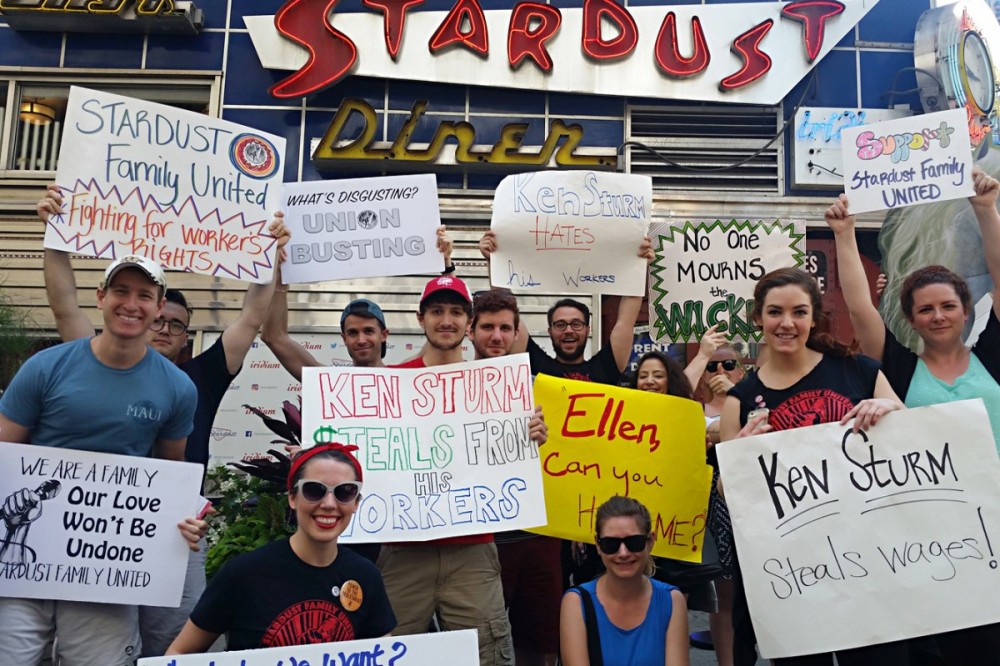"They make the laws / to chain us well" — "The World Turned Upside Down" (Leon Rosselson)
Strategic planners often use a swot analysis — Strengths, Weaknesses, Opportunities, Threats. It's useful to regard threats also as opportunities. These days, there is no shortage of threats to working-class people, but one of those ongoing threats, the Canadian labour movement's growing vulnerability to attacks on its legal framework, may well present an opportunity for labour to reconstitute itself as a force to be reckoned with.
That organized labour is declining in numeric strength is beyond doubt: Statistics Canada reports that the rate of unionization fell from 37.6 per cent in 1981 to 28.8 per cent in 2014. The trend is particularly pronounced among men and younger workers, in part because of the Canadian economy's shift away from the production of industrial goods to less-unionized retail and service work.
We're weaker not only in numbers but also in our bargaining power, and our power to mobilize union members to defeat attacks from their employers and governments.
In the Fall 2017 issue of Our Times, Linda Briskin noted the increasing use of lockouts by employers to enforce "ultra-concession bargaining," attacking not only workers' gains but also the foundation of the union itself — its members' power: "Unlike concession bargaining which includes wage freezes and cuts, two-tiered wage systems . . . benefits, pensions, and work rules, an additional motive of ultra-concession bargaining is "to weaken and displace unions" (quoting Gary Chaison).
Back-to-work legislation is also on the rise. The Canadian Foundation for Labour Rights, founded in 2010, notes "a major change in the frequency and severity of back-to-work legislation in Canada in recent years . . . In the last three decades, the federal government alone passed 19 pieces of back-to-work legislation while provincial governments across the country have enacted 73 pieces of back-to-work legislation. Most of this legislation (50 of the 92 pieces of legislation) not only forced workers back to work after taking strike action, but also arbitrarily imposed settlements on the striking workers."
In a one-two punch, therefore, workers are locked out by employers and legislated back by governments, neutralizing collective power and imposing concessions. Clearly this is an abuse of back-to-work legislation, which is supposed to be reserved as a last resort.
Recall what happened to postal workers in 2011 under the Conservative federal government. The Canadian Union of Postal Workers (CUPW) filed an ultimately successful Charter challenge, but the court's decision did not come until 2016, by which time the concessions that resulted from that back-to-work legislation had been in full force for several years. They were not rescinded.
Perhaps it is time for us to challenge not only the constitutionality of such attacks, but also the historic legal framework which allows them to happen.
REFLECTING ON RAND
Unions submit to these injustices because they are chained by labour law codified over the years since Justice Ivan Rand imposed labour peace by settling a strike of thousands of Ford workers in 1946. That decision, following waves of militant strikes during the 1940s, resulted in the "Rand formula" of mandatory dues check-off, whereby employers must deduct dues from all employees in a unionized workplace and remit them to the workers' union. In return, unions must abide by the understanding that strikes during the life of their collective agreements are illegal.

Workers create a blockade during the Windsor Ford strike of 1945. PHOTOGRAPH: CITY OF TORONTO ARCHIVES, GLOBE AND MAIL FONDS, FONDS 1266, ITEM 9999 1
Union membership is thus divided into "Rands," as they are popularly known in labour circles, those who are not active, card-carrying members of the union itself but are compelled to pay dues as members of a bargaining unit, as opposed to "MIGS" or members in good standing, who theoretically have more privileges, such as the ability to hold office. In many unions, the former vastly outnumber the latter.
Many union members do not even realize they are "Rands," since few card-signing drives happen in their workplaces. The existence of the union suffices, creating a soothing carousel of bargaining rounds, with most members called to mobilize for action only when their contract comes up for renegotiation.
The automatic collection of dues via the employer was originally considered a win for the labour movement by most. Some workers at the time, though, warned that the "company security" enshrined by the Rand formula was an attempt "to meet and undermine the great rise of union militancy that is spreading over Canada" by holding the "check-off purse-strings" and forcing unions to become "a strike-breaking agency" (Camfield, 2002, 188).
Others were concerned that the legislation would foster distance between union leaders and rank-and-file workers. And indeed, there is a material class separation within union structures where a caste of professionalized and highly paid (compared to their members) union leaders and staffers acquire expertise in technical and legal processes such as grievances and arbitrations.
While it must be acknowledged that many of these workers put in long hours running the day-to-day operations of the union — often at the expense of their personal lives, it must also be considered that, as union leaders ascend, sometimes holding positions for decades, they might also lose touch with the actual workplaces they represent.
Moreover, when those bargaining on behalf of their members will never have to endure workplace concessions themselves, aren't the conditions created for the professional caste to find it more reasonable to ask their members to settle for less?
OUR POWER OUTLAWED?
In its November/December 2005 issue, the New Socialist ran a piece by Sebastian Lamb entitled "The Rand Formula: Heart and soul of the labour movement?" For Lamb, Rand entails the "bureaucratization of unions" and:
"The duties it imposes on union officials give them a greater interest in opposing direct action on the job and policing workers, all for the sake of keeping the dues flowing. The mandatory payment of dues by check-off insulates officials from workers: when all workers must pay dues no matter what union officials do, officials have less reason to respond to workers' concerns."
Lamb goes on to note that "The Rand Formula is one of the reasons why, ironically, few unions today are capable of the kind of law-defying militancy and solidarity that won the 1945 Ford strike."
Mikhail Bjorge notes that, even prior to Rand, "when unions and their leadership played within the realm of industrial legality they generally lost; when workers agitated within the realm of direct action they were largely effective . . . normative, top-down strikes deeply concerned with industrial legality were generally failures. Snap strikes, wildcats, illegal strikes, sympathy strikes, and actions produced from the shopfloor itself were far more productive for workers."
While the labour movement has historically venerated such acts of resistance, we find ourselves in a time where exercising this type of power is outlawed. As Bjorge writes, "Canadian labour law was designed, at its heart, to stymie effective actions. Not only this, it was constructed to channel these less effective tactics into a legal realm where they were the sole option."
Now, more than 60 years after the establishment of our legal labour framework, where do we find ourselves?
Currently, in between contracts, union offices issue a steady stream of statements, fact sheets and the like, while leaders and activists campaign on issues, lobby politicians, keep lawyers busy, and make speeches at lunchtime rallies, rallies which are too often wrongly equated with mass mobilizations.
Despite these activities, we increasingly see many of our leaders floundering when faced with the growing onslaughts of vicious austerity attacks on workers and public services.
These attacks require real mass mobilization and movement-building to overcome — a type of unionism that is distinct from the business unionism that focuses on negotiating contracts or the social unionism of winning elections. David Camfield (2007) suggests that social movement unionism has as its goal the building of a "broad social movement of unions and community-based organizations to change society" founded on democratic workers' control, which challenges the types of divisions between workers that the Rand formula has helped entrench.
But this type of movement is difficult to build when, back on the workfloors, the everyday grind of challenging employers within the confines of the legal framework is left either to the professionals or to beleaguered shop stewards.
Of course, strikes change this situation because they galvanize more rank-and-file union members into increased militancy, attract new activists, and expose labour exploitation. But when all actions are governed by labour legislation, which unions dutifully obey and employers cynically manipulate, it becomes more and more obvious with each concessionary or status-quo contract, with each contrived lockout and back-to-work order, that legalized strikes are less and less effective, especially when union leaders must submit and bring members back to work under threat of heavy financial penalties, not only to their organizations but to themselves personally.
As Bjorge points out, we seldom situate Rand in its historical context, regarding it as the be-all and end-all of an institutional labour system. But if Rand is the carrot dangled by capital to buy itself labour peace and if the right to strike effectively, on our own terms, is the price we pay for that carrot, is it worth it?
If it's simply a matter of keeping the dues flowing, we might ask why it is still necessary to have employers deducting dues at all. Why couldn't we go directly to our members? The union could collect dues by equipping its representatives with union-made and supported financial technology. Such a thing was impossible in Rand's day, which is why dues check-off was such a significant issue for earlier union struggles, but it would be much easier now.
Today's unions, with their multiple departments, affiliations, and networks, surely have the resources to organize their own software applications to sign members up for a "direct deposit" of their dues, even in enormous bargaining units. The use of direct deposit, with which so many non-profits and grassroots organizations sustain themselves nowadays, would make going to the members much easier. Why then would we handcuff ourselves to outdated labour legislation and abide by no-strike clauses for Rand's old carrot?
People object, understandably, that forcing unions to collect their own dues would significantly weaken their capacity by reducing their financial resources. If we were to scrap Rand, the collection of dues might possibly be made voluntary, compelling representatives to go to new hires and sign them up or persuade members to retain their memberships. But building strong unions with more democratic control would encourage members' ongoing participation and support. The original demand of the Ford UAW strikers, a closed shop, might well regain its significance in this context: only paid-up union members would work.
SOLIDARITY AND THE STARDUSTERS
In case this sounds like pie in the sky, let's not forget that we already have examples of unions that successfully do things this way, such as the Industrial Workers of the World (full disclosure, I'm a member).
The IWW tends to (though not always) forgo contract unionism, opting instead for a "solidarity unionism" founded upon the action and involvement of the members on the workfloor, as opposed to "bureaucratic unionism" which relies on legalized processes such as grievances, arbitrations and labour law to address workplace issues. The IWW's grievance process consists of the members collectively deciding which issues to take up and acting upon them.
Take the case of the Stardust campaign, which started in January 2016 when the IWW branch in New York was approached about Ellen's Stardust Diner, a popular tourist spot in Times Square known for its singing wait staff or "Stardusters," who perform Broadway and popular hits as they work. A new management team made a change for the worse in the staff's working conditions. Long-term workers got bullied and fired.
After the Stardusters were turned down by the actors' union (since they weren't being paid specifically for their singing performances), they turned to the IWW, which happens to have a long history of musical expression. (Many of the labour movement's most well-known anthems, including "Solidarity Forever," were produced by Wobblies.)
The IWW began running organizer trainings or "101s" every couple of months and helped build a functioning internal committee. According to Marianne Garneau, an IWW organizer who worked on the drive, 65 out of 70 of the diner's staff got on board and began coming to meetings. Other committees — such as outreach and media — formed.
Staff began to take collective actions such as demanding their tips back. (The new management had taken away a red tip bucket that the servers passed around as they sang, the only form of compensation they received for their performances.)
One night, the Stardusters broke into "My Shot" from the musical Hamilton, patrons raised ketchup bottles in the air in support, and a march on the boss took place with the servers demanding their tip bucket back. They got it.

PHOTOGRAPH COURTESY: STARDUST FAMILY UNITED
Garneau points out one great advantage of solidarity unionism: when it takes place outside the conventional processes by which we have come to understand unions forming, bosses often do not recognize it until the union has gained sufficient strength and power to stand up to them. In the case of the Stardusters, management remained unaware of their union organizing until they went public with basic demands — adequate staffing, better health and safety, and a fair discipline policy.
When the employer resisted, 16 of the Stardusters held a banner demo outside the diner. They were fired. Fifteen more servers were fired in a second round. Eventually all the fired workers, with the help of a lawyer working pro bono, won a settlement and the right to reinstatement via mediation with the National Labour Relations Board (NLRB).
While the use of a lawyer and the NLRB process may seem inconsistent with the concept of solidarity unionism, note that this legal tactic complemented but did not replace actions taken by the workers themselves.
Regardless of their firing, the workers continued to picket the diner, attend meetings and pay dues to the IWW. At the same time, the remaining staff bombarded the employer with demands and engaged in work refusals and other actions. For example, servers were asked to learn two new songs to perform during their shift on New Year's Eve. The eight who were scheduled to work that night took a vote and most voted no to learning the new songs. Instead they delivered a letter of refusal to management.
"They just keep winning," Garneau repeated several times during our interview, referring to Starduster victories such as a $15 hourly wage for all hosts. A longstanding demand for a nursing station was finally successful. Management also used to claw back 7 per cent of the 18 per cent gratuities that were automatically calculated on bills for large tables. One Friday, another march on the boss took place, in which workers doing different jobs participated, including servers, runners, bussers and hosts. A letter was delivered demanding a response by noon on a Monday. Management conceded at 11:56 a.m. on that Monday, four minutes before the deadline was up

PHOTOGRAPH COURTESY: STARDUST FAMILY UNITED
In contrast to the stereotype of young, carefree activists, the Stardusters count among their numbers many older married people, long-term workers with children who are not in the habit of being carried away by idealism but who committed to act nonetheless.
"No students, no leftists, no LARPing," Garneau joked (referring to "live action roleplaying," in political terms, as a revolutionary). "They're not radicals . . . but Stardust is the most true example I've seen of workers implementing solidarity unionism.
"When I tell people I'm organizing singing waiters, I get a lot of scorn . . . But you want working-class militancy?" Garneau tells me about petite women, Broadway performers, jumping onto delivery trucks driven by Teamsters to enforce the picket line. "They're used to taking control of their own destiny. That's not contract stuff."
SEE THE UNION, BE THE UNION
IWW delegates collect dues directly and paying them is voluntary, which means some members may not always pay. Regardless, as Garneau puts it, "we're going to fight for you, it's not a club or a protection racket."
A greater responsibility is thus placed on the worker to not be a "free rider." All are expected to "see the union, be the union and pay your dues."
Notably, the Stardusters are paying their union dues using an app called Venmo, which prompts them to make the dues payment. Their delegates follow up with text messages or by communicating face to face.
While Venmo is owned by PayPal and issues of security and state shutdown of tech may arise, it is not the only app out there. It's not difficult to imagine unions themselves allocating resources towards developing tools that would allow them to bypass their employers' involvement in dues collection altogether.
Doing so would permit them to scrap the strings-attached strictures upon direct action. Under current labour law, any action might meet with charges of an "illegal work stoppage," even if the action in question is just a joint coffee break.
Regular face-to-face contact and direct communication is not a given for many unions, but all organizing drives and mobilization campaigns recognize its importance. What if we treated all union work, including dues collection, as organizing work? What if we empowered our members to take more direct actions without chaining them with labour law? And, if employers are flouting existing labour laws with impunity, isn't it time we question the usefulness of abiding by those laws?
The June 2018 Janus ruling by the Supreme Court of the United States, which held that forcing non-members to pay public-sector union fees was a violation of the First Amendment and which allowed the American equivalents of Rands to avoid paying dues or "agency fees," should serve as a warning. There is a clear danger, particularly with the election of Doug Ford in Ontario and the ascendancy of increasingly extreme right-wing forces, that the Canadian labour movement will be attacked in similar ways.
Perhaps it's time to organize ourselves in a way that makes the old Rand Formula wholly unnecessary. Perhaps the best way to defend workers is to say we no longer need the carrot and the no-strike deal is off because we're taking back the stick!
Some Ways We Could Start Rattling the Chains of Our Randcuffs
-
The labour movement as a whole must re-orient itself towards social movement unionism in its definition of solidarity. That includes actively involving grassroots and community organizations, many of which deal with unorganized and marginalized workers. One concrete way to undertake this is to help establish and support more Workers Action Centres, along the lines of those in Toronto and Montreal.
-
Unions could come together to discuss the financial technology needed to gain independence from employer-held purse strings. Together (ideally), they could also develop union-owned software for dues collection.
-
In addition to the shop steward system, which revolves around the contract, unions could be actively training and supporting a network of workplace agitators for mobilization, outreach and action — too often, the shop stewards and a handful of volunteers are expected to do it all.
-
Unions should not be afraid to look critically at their internal structures and processes, and find ways to be much more democratic and inclusive, and less caste-ridden and bureaucratic. This might involve measures such as imposing term limits and/or back-to-the-workfloor rotations upon elected officials; addressing brutal workloads built upon an outdated (and gendered) model of the sole "contract-winner" that serve also to concentrate knowledge and power in the hands of a few; finding concrete ways to incorporate better representation at all levels (for example, by having positions co-occupied by members of different equity groups); and actively educating, training and recruiting members at all times.
-
Finally, and perhaps most importantly, unions must remember and take up with renewed vigour the history of bold defiance, cross-societal organizing, and militant action that gained us the power to achieve institutional status in the first place. This, at some point, is going to involve challenging the increasing use of back-to-work legislation and supporting those who are willing to defy it.
— AA
"Solidarity Forever," which Ralph Chaplin wrote in 1915 for the IWW, has become one of the labour movement's most inspiring and frequently sung anthems. It can be found in the IWW's The Little Red Songbook, along with many other favourites. Over 38 editions of the songbook, all with bright red covers, have been published since the early 1900s, with the IWW earning the moniker "the singing union."
Aalya Ahmad is a long-time labour and feminist activist who has worked as a staffer at several unions and who has been a grassroots organizer for decades. She lives in Gatineau with her family. Get in touch with Aalya


_1000_595_90.jpg)












